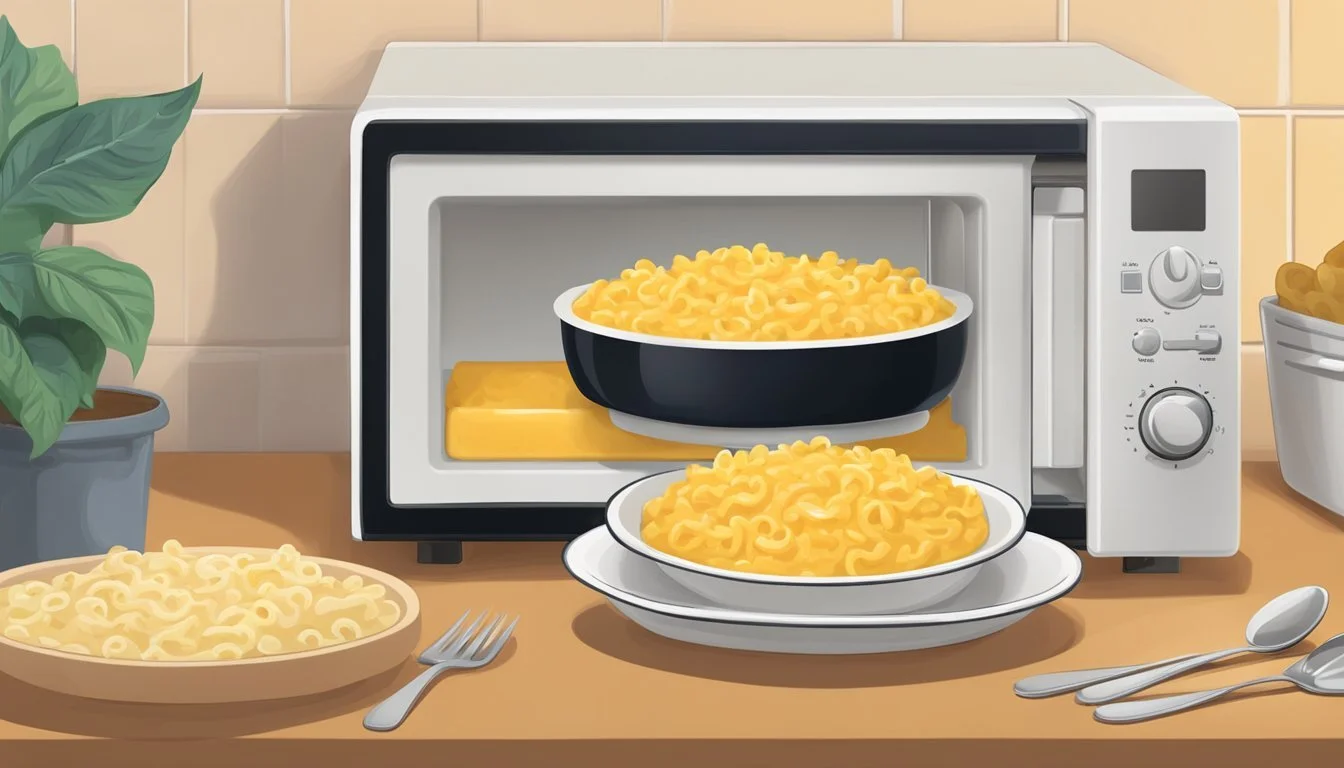How to Reheat Gluten-Free Mac and Cheese (cauliflower-based)
Step-by-Step Guide
For those looking to enjoy a comforting dish without the gluten, cauliflower-based mac and cheese offers a delicious alternative. Reheating this dish can be a breeze when done correctly. To maintain its creaminess and flavor, mix one tablespoon of milk for every cup of cauliflower mac and cheese before reheating.
The key to even reheating lies in covering the dish tightly with aluminum foil, locking in the moisture. Once prepared, bake the dish in a preheated oven. Check after 20-30 minutes to ensure the dish is heated through and retains its creamy texture.
Understanding Gluten-Free Mac and Cheese Ingredients
Gluten-free mac and cheese, particularly cauliflower-based, combines nutritious and delicious elements. This section delves into the key ingredients that make the dish gluten-free and suitable for various dietary needs.
Cauliflower as a Base
Cauliflower is a versatile vegetable that serves as a nutritious base for gluten-free mac and cheese. It provides a low-carb alternative to traditional pasta. Rich in vitamins C and K, cauliflower also adds a subtle flavor that complements the cheese sauce.
When using cauliflower, it's essential to cook it until tender but not mushy to retain its slight crunch. Steam or blanch the florets, then incorporate them into the dish. Opting for fresh cauliflower over frozen can enhance the texture.
Cheese Alternatives for Lactose Intolerance
For those with lactose intolerance, traditional dairy cheese can be replaced with various alternatives. Vegan cheeses made from raw cashews, almonds, and plant-based milk such as almond milk or soy milk are popular options.
Nutritional yeast can add a savory, cheesy flavor without the lactose. Look for vegan cheese brands that offer dairy-free cheddar, parmesan, or mozzarella to maintain the creamy, gooey texture of mac and cheese. Cashew-based cheese sauces are particularly creamy and rich in protein, making them a great substitute.
Gluten-Free Binding Agents
Binding agents help maintain the structure of gluten-free mac and cheese. Common gluten-free options include eggs, potato starch, and rice flour. These alternatives help achieve the desired creaminess and thickness of the cheese sauce.
For those avoiding eggs, chia seeds or flax seeds mixed with water can act as a binding agent. Gluten-free breadcrumbs made from rice or potatoes can add a crunchy topping. Butter and cream are often used in the roux to create a smooth sauce, with gluten-free flour substituting for traditional wheat flour.
Using these ingredients ensures the dish is suitable for gluten sensitivities while maintaining its classic texture and flavor.
Preparation Before Reheating
Proper preparation ensures your gluten-free mac and cheese made with cauliflower retains its texture and flavor. This involves suitable storage and meticulous thawing to prevent dryness and uneven heating.
Storing Your Dish Properly
To store your cauliflower-based mac and cheese, use airtight glass containers. If you baked the mac and cheese in a casserole dish, you can cover it with a robust lid or tight-fitting plastic wrap.
When refrigerating, the dish should be cooled to room temperature before sealing. This prevents condensation, which can make leftovers soggy.
For freezing, wrap the dish twice in plastic wrap and a layer of aluminum foil. Label and date your containers. Pre-shredded cheese or sauce layers should be separated if possible to avoid texture changes upon reheating.
Thawing for Even Reheating
Before reheating, move your frozen mac and cheese from the freezer to the fridge. This slow thawing method, ideally overnight, ensures even reheating and keeps the texture intact.
Avoid thawing at room temperature, as this can lead to uneven temperatures, risking bacterial growth and decreased quality. To maintain moisture, stir in a splash of milk (or dairy-free alternative) before reheating.
For a microwave, allow refrigerated mac and cheese to rest for a few minutes at room temperature. This step optimizes reheating time and improves texture. A damp paper towel over the dish helps retain moisture and prevents the cauliflower from drying out.
Reheating Techniques
Reheating gluten-free mac and cheese, particularly when made with cauliflower, requires special attention to preserve its texture and creaminess. Below are methods for both oven and microwave reheating, with additional tips for maintaining a creamy sauce.
Oven Reheating for Optimal Texture
Preheat the oven to 350°F (175°C). Transfer the cauliflower-based mac and cheese into an oven-safe baking dish.
Add 1 tablespoon of milk or cream per cup of mac and cheese to prevent dryness.
Cover the dish tightly with aluminum foil to lock in moisture. Bake for 20-25 minutes until heated through.
Remove foil and broil on high for 1-2 minutes if a crisp top is desired but not necessary for creamy texture. This method ensures even heating and helps maintain the dish's consistency.
Microwave Reheating for Convenience
Microwave reheating is ideal for single or small servings. Place a portion in a microwave-safe bowl.
Stir in 1 tablespoon of milk or cream per cup of mac and cheese to maintain a creamy sauce.
Cover the bowl loosely with a damp paper towel or microwave-safe lid to retain moisture. Heat on medium power for 1-2 minutes, stirring halfway through.
Repeat in short intervals if not fully heated. This method is quick and maintains the dish's moisture when done carefully.
Additional Tips for Maintaining Creaminess
When reheating gluten-free, cauliflower-based mac and cheese, always add a splash of liquid like milk, cream, or an alternative milk to restore creaminess. Avoid overcooking to prevent drying out the sauce.
If the cheese sauce separates, stir vigorously or use a fork to whisk it back together gently.
For an extra creamy result, consider incorporating a bit of freshly grated cheese before reheating. This can help blend the sauce back smoothly while reheating.
Incorporating these tips can make a significant difference in preserving the desired texture and taste of the dish.
Adding Flavor and Texture After Reheating
To elevate your reheated gluten-free cauliflower-based mac and cheese, focus on three key areas: spices and seasonings, a crispy topping, and fresh ingredients.
Enhancing with Spices and Seasonings
Enhancing the flavor of your dish with spices is straightforward and effective. Salt and black pepper are essential to bring out the natural flavors. For a bolder taste, consider garlic powder and onion powder.
Smoked paprika adds a smoky depth, while a pinch of cayenne pepper can provide a subtle kick. A small amount of turmeric can introduce an earthy note and vibrant color, enriching the overall taste profile. Milk can help incorporate these seasonings smoothly, especially if the dish feels dry after reheating.
Creating a Crispy Topping
A crispy topping can transform the texture of your mac and cheese. Begin by mixing gluten-free breadcrumbs with a bit of olive oil or melted butter until combined. A small quantity of salt and black pepper can also enhance this mixture.
Spread the breadcrumb mixture evenly across the reheated mac and cheese. Place it under a broiler for a few minutes until the top is golden brown and crispy. For additional flavor, sprinkle garlic powder or smoked paprika over the breadcrumbs before broiling.
Incorporating Fresh Ingredients
Fresh ingredients can add a delightful contrast in texture and taste. Chopped fresh herbs like parsley or chives can provide a vibrant finish. Adding diced onions or garlic sautéed in olive oil can introduce new layers of flavor.
For an extra crunch, consider tossing in some lightly steamed broccoli or roasted cauliflower florets. These additions will not only vary the texture but also enhance the nutritional profile. Ensure that these ingredients are well-drained to keep the mac and cheese creamy rather than watery.
Serving and Pairing Suggestions
Cauliflower-based gluten-free mac and cheese can be a delightful main dish that pairs wonderfully with a variety of side dishes. Thoughtful presentation and complementary sides can elevate your dinner experience.
Presentation Ideas
To make your cauliflower-based mac and cheese look appealing, consider individual ramekins. They are perfect for keeping portions neat and impressive for guests. For a family dinner, a large casserole dish with a golden-brown breadcrumb topping can be both inviting and appetizing.
Garnish with finely chopped parsley or chives. The green adds a pop of color and freshness. Crispy bacon bits can add texture and a savory note, making it enticing for both kids and adults. Arrange pieces of roasted vegetables around the edges for an attractive and colorful presentation.
Complementary Side Dishes
Pair your mac and cheese with a light and crunchy side salad, such as mixed greens with a tangy vinaigrette. The freshness of the salad balances the creaminess of the main dish. Steamed or roasted vegetables like broccoli, green beans, or brussels sprouts provide both nutrition and a complementary texture.
For a heartier option, serve with garlic bread or cornbread. These sides add a different texture and can help make the meal more satisfying. Grilled chicken or baked bacon-wrapped asparagus can also complement the flavors, making the meal suitable for a more substantial dinner. Kids and adults alike will enjoy the combination of flavors and textures.






